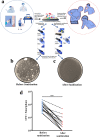Germi-X herbal-based spray disinfects smartphone surfaces: implication on fomite-mediated infection spread
- PMID: 35244805
- PMCID: PMC8894557
- DOI: 10.1186/s13568-022-01369-y
Germi-X herbal-based spray disinfects smartphone surfaces: implication on fomite-mediated infection spread
Abstract
Inanimate objects/surfaces become fomites upon contacting infectious agents such as disease-causing bacteria, fungi and viruses. Smartphones are one of the most prominent among these fomites. COVID-19 pandemic has raised the awareness on mobile sanitization, as an active measure to curb fomite-mediated viral transmission. Available mobile sanitizers and ultraviolet (UV) ray mediated mobile sanitization have their own sets of pros and cons, often being less user-friendly. This study explored the germicidal efficacy of an herbal-based sanitizer, Germi-X spray, on hands and mobiles, through microbiological techniques of micro-broth dilution and Kirby-Bauer disc diffusion assay, thumb print assay and swab test. Notably, Germi-X spray was found to be 6-67% more effective against surface pathogens, like, Staphylococcus epidermidis, Staphylococcus aureus, Pseudomonas fluorescens and Pseudomonas aeruginosa, as compared to a very popular product in the Indian market, which was taken as a control for this study. The observed anti-bacterial activity of the spray from disc-diffusion assay suggests its greater surface retentivity as compared to the control. Germicidal potency of Germi-X spray, when used to sanitize hands, was found to be greater than 80%. There was ~ 17-fold reduction in microbial counts after sanitizing smartphones with Germi-X spray. The novelty of this study lies in providing experimental evidence for this herbal-based surface sanitizer in efficiently disinfecting one of the super contaminated fomite, the smartphones. In conclusion, having an herbal base with a high germicidal efficacy against surface pathogens, together with longer surface retention, Germi-X spray appears to be an eco-friendly and cost-effective sanitizer for the surfaces of electronic gadgets like smartphones.
Keywords: Fomite-based infection; Germicidal; Hand and mobile sanitizer; Herbal-based spray; Surface contamination.
© 2022. The Author(s).
Conflict of interest statement
The test article was sourced from Patanjali Ayurved Ltd., Haridwar, Uttarakhand, India. In addition to Patanjali Research Foundation Trust and University of Patanjali, Acharya Balkrishna holds an honorary managerial position in Patanjali Ayurved Ltd, Haridwar, India. Besides, providing the test articles, Patanjali Ayurved Ltd. was not involved in any aspect of this study. Other authors, Kanchan Singh, Swati Haldar, and Anurag Varshney, are employed at Patanjali Research Institute which is governed by Patanjali Research Foundation Trust (PRFT), Haridwar, Uttarakhand, India, a not-for-profit organization. In addition, Anurag Varshney is an adjunct professor in Department of Allied and Applied Sciences, University of Patanjali, NH-58, Haridwar-249405, Uttarakhand, India; and in the Special Centre for Systems Medicine, Jawaharlal Nehru University, New Delhi-110067, India. All other authors declare no competing interests.
Figures





Similar articles
-
GermiX: A skin friendly hand sanitizer with prolonged effectivity against pathogenic bacteria.AMB Express. 2020 Dec 1;10(1):210. doi: 10.1186/s13568-020-01151-y. AMB Express. 2020. PMID: 33259026 Free PMC article.
-
Fomite disinfection using spray systems: A computational multi-physics framework.Environ Int. 2024 Sep;191:108908. doi: 10.1016/j.envint.2024.108908. Epub 2024 Jul 25. Environ Int. 2024. PMID: 39186903
-
Ultraviolet-C-based sanitization is a cost-effective option for hospitals to manage health care-associated infection risks from high touch mobile phones.Front Health Serv. 2025 Jan 13;4:1448913. doi: 10.3389/frhs.2024.1448913. eCollection 2024. Front Health Serv. 2025. PMID: 39872038 Free PMC article.
-
On the emergence of antibacterial and antiviral copper cold spray coatings.J Biol Eng. 2021 Feb 24;15(1):8. doi: 10.1186/s13036-021-00256-7. J Biol Eng. 2021. PMID: 33627170 Free PMC article. Review.
-
Back to Basics: Choosing the Appropriate Surface Disinfectant.Antibiotics (Basel). 2021 May 21;10(6):613. doi: 10.3390/antibiotics10060613. Antibiotics (Basel). 2021. PMID: 34063833 Free PMC article. Review.
References
-
- Boone SA, Gerba CP. The prevalence of human parainfluenza virus 1 on indoor office fomites. Food Environ Virol. 2010;2:41–46. doi: 10.1007/s12560-010-9026-5. - DOI
LinkOut - more resources
Full Text Sources
Miscellaneous

